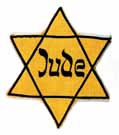
|
|
|

|

|

|

|
|
Click on an image to see a larger, more detailed picture.
|
|
|
|
|
| 1939: The War Against The Jews |

|
pg. 177 |

|
|
|
|
| |
 An elderly Jew, wearing what was probably a homemade Yellow Star, engages in forced labor. The Nazis enjoyed making Jews, whom they considered "work shy," engage in heavy labor. Jewish workers toiled under horrific conditions, working at extremely arduous tasks but receiving starvation rations. Thousands of Polish Jews, especially the sick and elderly, died as a result of this abuse.
An elderly Jew, wearing what was probably a homemade Yellow Star, engages in forced labor. The Nazis enjoyed making Jews, whom they considered "work shy," engage in heavy labor. Jewish workers toiled under horrific conditions, working at extremely arduous tasks but receiving starvation rations. Thousands of Polish Jews, especially the sick and elderly, died as a result of this abuse.
Photo: Jerzy Tomaszewski
|
 Partisans proved a thorn in the side of the Germans throughout the course of the war. This Polish-Jewish woman, Bayla Gelblung, appears before a Nazi military court in October 1939. A sharpshooter, she stands accused of firing on German soldiers. Notice her military uniform; civilians accused of sniping were summarily executed.
Partisans proved a thorn in the side of the Germans throughout the course of the war. This Polish-Jewish woman, Bayla Gelblung, appears before a Nazi military court in October 1939. A sharpshooter, she stands accused of firing on German soldiers. Notice her military uniform; civilians accused of sniping were summarily executed.
Photo: UPI/Corbis-Bettmann
|
 The Yellow Star
The Yellow Star
With the crushing defeat of Poland, the Nazis launched the policy of publicly identifying Jews. As a means of identification and humiliation, Jews would be forced to wear the Star of David. Noncompliance was punishable by death. All Polish Jews over the age of ten were forced "to wear on the right sleeve of their inner and outer garments a white band at least four inches wide, with the Star of David on it." This stigmatizing label became a standard feature of Nazi policy throughout Occupied Europe. The Nazis cynically called the star Pour le Sémite (for the Semite), a pun on the German military decoration for valor, Pour le Mérite (for the Merit). Branding Jews with the Star of David turned the symbol of Judaism into a badge of deep humiliation--and a form of torture. To merely go into the street meant being immediately recognized, monitored, shunned, abused, and ultimately marked for death. Jewish children, especially, were easy targets of verbal and physical attacks. The placement, design, and colors of the badges varied. Initially, most were yellow triangle-shaped patches, some sewn onto lapels. German Jews wore a yellow star inscribed with the word Jude in black letters. In Dachau, two overlapping triangular patches formed a yellow star. Armbands in the Warsaw Ghetto featured a blue star. The badges of Greek Jews contained identity numbers. Russian Jews wore yellow badges on the left side of the chest and on the back.
|
|

|

|

|

|
 October 26, 1939: October 26, 1939-early February 1940: In a plan devised by Adolf Eichmann, the Nazis deport and "resettle" some 78,000 Jews to a "reservation" located in the Lublin-Nisko region of southeast Poland. The project is temporarily suspended when rolling rail stock is needed for German military campaigns against the Low Countries.
October 26, 1939: October 26, 1939-early February 1940: In a plan devised by Adolf Eichmann, the Nazis deport and "resettle" some 78,000 Jews to a "reservation" located in the Lublin-Nisko region of southeast Poland. The project is temporarily suspended when rolling rail stock is needed for German military campaigns against the Low Countries.
|
 October 30, 1939: SS chief Heinrich Himmler designates the next three months as the period during which all Jews must be cleared from the rural areas of western Poland. Hundreds of communities will be affected, and thousands of Jews will be expelled with nothing but what they can carry with them.
October 30, 1939: SS chief Heinrich Himmler designates the next three months as the period during which all Jews must be cleared from the rural areas of western Poland. Hundreds of communities will be affected, and thousands of Jews will be expelled with nothing but what they can carry with them.
|
 October 30, 1939: The British government publishes a report critical of the Nazis' treatment of concentration-camp prisoners.
October 30, 1939: The British government publishes a report critical of the Nazis' treatment of concentration-camp prisoners.
|
 November 1939: Various German generals plot a Putsch designed to overthrow Hitler at Zossen, Germany, but it is never carried out.
November 1939: Various German generals plot a Putsch designed to overthrow Hitler at Zossen, Germany, but it is never carried out.
|
 November 1939: Hans Frank, governor-general of Occupied Poland, sets up the first "self-governing" Jewish council (Judenrat) within Jewish ghettos. The council leaders must obey the demands of the Nazis.
November 1939: Hans Frank, governor-general of Occupied Poland, sets up the first "self-governing" Jewish council (Judenrat) within Jewish ghettos. The council leaders must obey the demands of the Nazis.
|
|
|
|
|
| 1939: The War Against The Jews |

|
pg. 177 |

|
|
The Holocaust Chronicle
© 2009 Publications International, Ltd.
|
|
